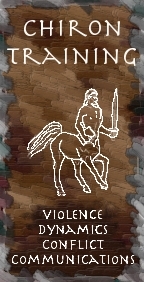|
|
||||||||
|
Search NNSD In This Hub: Adrenaline and Brain Wiring Anger Assertiveness Blame Body Sacrosanct Boundaries Bullies Conflict Cycle* De-escalation Fear Fear vs. Danger Fight or No? High Risk Behavior Kinds of Violence Monkey Brain Negotiation In Extremis Normal, Abnormal, Dangerous Pride, Fighting, Self-Control Provoking An Attack Rights Self-Esteem vs. Self-Respect Unintended Consequences Violence ISN'T What You Think It Is What's With the *? Rape Hub Self Defense Hub Streetfighting Hub NNSD Home Page Donate to NNSD
Marc MacYoung?
|
Just because something is dangerous Disneyland State of Mind / Hermit Crabs
On this page: I want to talk about two incredibly dangerous attitudes. Not dangerous in the sense of predation, but dangerous in the sense of when people have them things can turn violent in a matter of seconds. One of these attitudes (DSoM) is a small step from a fanatical level of self-righteous fury and violence. What's scary is it's rooted in having a really good time. In this state, whatever level of harm they do you ... well, let's just say you 'deserve it' because you dared to interfere with their 'fun.' The other version (Hermit crabs) leaves you easy prey to predators. (Like you cutting yourself and jumping into a shark tank 'easy.') While many sound-bite self-defense instructors will tell you "don't look like a victim," this form of 'confidence' will have a predator targeting on you faster than being mousey ever will. These two models have roots in the works of Lawrence Gonzalez, Jonathan Haidt and me being incredibly hung over at Disneyland. Believe it or not, all were necessary. I wouldn't have recognized the importance of Gonzalez's work, if I hadn't had a hang over that day. I couldn't explain how deep this 'moral outrage' runs without Haidt. With DSoM, I'm talking about people who think they're right with God over what they do to you for telling them "no.") You can skip straight to the Disneyland State of Mind (DSOM) and Hermit Crab Mindset (HCM). But, much of what's going on is unconscious, subconscious and dangerously self-righteous. The back story and foundations will help you understand and recognize these dangerous attitudes. Not just from the standpoint of you not falling into them, but you not being physically injured when you run across them. Because when you get cross wired someone in the DSoM, you're dealing with a violent fanatic. I want to stress again: Although these attitudes are not themselves
violent in nature, both are a small step from
all hell breaking loose. I'm talking blood on
the floor trouble. And it might just be yours.
Trip to Anaheim We were standing in line for a ride. Wait, let's be honest, she was standing, I was propped up against the handrails that created the switchbacks in the line. The line moved forward and she walked ahead. I just crabbed sideways. The rail was smooth and standing up was just too much work. As I slid along the rail I felt a hole open up under my hand. Looking down I saw the horizontal wooden rail was bolted to an upright metal post. Okay, no big deal, except the hole I felt was a countersink. Someone had drilled down just enough so the bolt's head didn't stick up from the wood. A very small thing, but it was a level of safety consciousness you don't normally see. Despite only running on a few cylinders -- or perhaps because of it -- I immediately recognized with the countersink, you couldn't accidentally rip your hand open on the head of the bolt. Yet it wasn't deep enough to get your finger caught either. When I saw that, I started noticing a number of other small, safety measures all around us. I oriented on these measures and my brain and adrenalin kicked in. Screw the hangover, this was important on a professional level. I've worked event security, crowd control and all kinds of other safety jobs. Safety and preventing accidental injury are deeply ingrained into my thinking. I was stunned by the number of measures, the attention to detail and-- most of all --their subtlety. These measures were everywhere. Yet, they were well blended into the environment they were literally invisible to the average person. Professionally, I was amazed how well designed the whole park is. Disneyland put a lot of thought, time and money into safety. It was so well done I even started imagining ways people could be injured. For every credible scenario I could come up with, I saw counter-measures already in place. Everything from rounded corners, sanded and shellacked surfaces, joints without the slightest gaps, countersunk bolts, traffic flow, design, recessed trash cans and street lights (no walking into them while texting), and even rounded curbs (in case a running child trips). Bottom-line: To get injured at Disneyland you really have to be working at it. Years later this was confirmed when I was talking to an employee. He told me the behind- the- scenes 'tour' of Disneyland starts with the statement that safety is their number one priority. Here is something to think about. You pay for that safety. It's not just entertainment you're buying with your ticket. The admission price includes Disneyland doing everything possible for your safety-- while entertaining you. That means, on their property, you don't have to think about safety. They've taken that job over for you. After you've paid to get in, all you have to do is focus on being entertained. In short, you are safe while having a good time. So there is a place where you can be completely safe and entirely focused on having a good time. It's called "The Magic Kingdom." At the same time, you pay for that privilege. Not just 'taxes,' but extra cashy-money. Safety ain't cheap. Nor is it free. Yet how many people have the attitude that
the world should be Disneyland? That they have a
right to safety and entertainment -- without
paying? Unfortunately the answer is: A growing
number.
Vacation State of Mind This is a deeper of a subject than most people realize. Namely because so much of our safety habits are actually subconscious, habitual and -- this is important -- faster than conscious thought. Those points make this a subject worth looking at more closely. How so? First, most
people don't realize how imbedded safety
measures are in their lives. Now ask yourself, how does that affect your thinking? (Simple question, deep answers.) Second you know the local ones, but
you don't know the danger signs or safety
protocols in other environment. Third, your habits are for your
environment. Fourth, often what you think you
know about another environment comes through
filters. This point has a few sub-variants we need to consider. I'll use explosions as an example: Quick, what's the blast radius when the gas tank of a car on fire goes off? If you must approach a burning vehicle, which direction should you come in from? This brings us to those filters. Some of which are: Hollywood/ entertainment -- This is pure fantasy. The art of movie making has all kinds of rules, tricks and tropes. It is also designed to be visually striking. How many times have you seen the hero(es) outrunning and dramatically jumping with an explosion in the background? This is flat out wrong. You can't outrun an explosion. Also, there is no blast radius on TV -- except for when it is visually striking. Blast radius and direction exist in the real world. Youtube -- This is one of the harder filters to detect, because on one hand yes it's real footage, but there's no blast radius on TV, computers or phones. You see something, but you don't understanding what you're seeing. You see a professional running to a burning car to pull someone out. What you don't recognize is he's approaching from the corners. (The construction of the car directs blasts and shrapnel.) You don't want to just run up to a burning car. Camera shield -- A new, but growing trend is we put a filter there by filming. Think about something you know to be dangerous. How many times have you seen someone filming as if, somehow, their phone is a magic bubble that shields them from harm? You want to film a burning car? Use the zoom feature. Don't walk up to get a better shot; that puts you in the blast radius. Fifth, peer pressure can play a big
part in what you do. Sixth, an all too common
attitude is when you're 'on vacation you
don't have to think.' Bundling these six points together for everyday general safety I'll point out We're grown accustomed to watching in safety. In fact, we often watch horrible things as either news or entertainment. In your home, that's fine. However, often we take this assumed safety out with us. This goes beyond just slowing down to rubberneck over a traffic accident. It goes up to stand there watching as bad things are happening. Here's an important safety tip: If something is going down, don't stand there and watch. This is live, not TV. If you're going to treat it like it is, then go home, turn on the TV and watch it from the safety of your living room. Relevant to this subject, scale down the sixth point, to "I'm out having fun tonight." Many people develop a micro-version of vacation state of mind when they're out on the town. I'll tell you a story about that in a bit. Before moving on to you being involved in violence, I'd like to point another important factor about our assumptions of safety. That's the number of variables. It's not something I'm going to go into because of time restrictions. But if you pursue the subject of safety, look into an interesting correlation. The greater control there is over an environment, the less we -- as individuals -- have to think about safety. Using previous examples, contrast the enclosed and controlled environment of Disneyland with wild animals at National Parks. One is under way more control. What's interesting is this correlation holds true even in circumstances where there is greater risk (For example, we take freeway driving for granted, despite it being the most dangerous thing you routinely do. Yes, every year tens- of- thousands people die in accidents. At the same time, how much control is there? You may not think so, but it's incredibly controlled. Look at the design, construction, signs and traffic laws that allow hundreds of millions to safely use the freeways every day. Hundreds of millions a day vs. tens of thousands a year. That's pretty impressive.) Once again, "What is the effect all this safety on our thinking?" An especially important question is: With more or less variables, how much does the individual think he/she is in control of those OR does the person believe he/she doesn't have to bother with them at all? Then the next question, how is such a person going to react? I'll give you an example. I was riding in a car with Kris Wilder (one of the authors I recommend). It was Friday night and we were going to a restaurant in a popular part of West Seattle. We were turning a corner. On that corner was a group of young women, standing, talking to each other. They were not moving as we started to turn. In the middle of our turn, two of the women, spun around and stepped out in front of us. No looking, no hesitation, just turn and step into the street. Kris slammed on the brakes. It was the reaction of the women that was interesting. First fear, then anger. In fact, one of them slapped the hood. Ask yourself: Why did she feel confident enough to hit the car of two strangers? The answer is an assumption of safety. And it was an assumption. While her hitting the car was a purely emotional response, look at what was behind it. It was girls-night -out for them. She and her friends were deep in a micro-version of vacation state of mind. When something unexpected happened her immediate reaction was anger. While nothing happened (because we chose not to react) both Kris and I have... well let's just say "dim pasts." Had we been 25 years younger, our reaction would have been different. The question is: Would hers have been different? The speed of how fast she hit the car suggests not. All that mattered at that moment was her feelings of anger and frustration. Put a push-pin in this idea, we'll come back to it. In passing I'll mention a field of study
called "Disaster Sociology." It's basically how
people 'think' and behave in emergencies-- and
how that often gets them killed. If you're
interested in human behavior, it's a fascinating
subject. Even if you're not, by taking a look at
it you'll learn a lot about what not to
do when things are happening. Things outside
your everyday experiences. Once again, we
haven't gotten to violence, this is just
'something happened today' safety.
Taking Things A Step Further We're now moving into conscious behaviors. But behaviors based on subconscious assumptions and ...well, flat out misinformation. Myths and lies that are being promoted as unquestionable truths. The reason I mention this subject is it has a lot to do with current trends of entitlement and privilege (I have the right to _____") It also lends itself to people believing, "I shouldn't have to do _____" Especially among the young, this can go as far as they have a 'right' to do stupid, illegal and dangerous without consequence. Mix that in with an assumption of safety and we're three quarters the way to the Disneyland State of Mind and the Hermit Crab Mindset. To fill in the remaining bit, I'd like to direct your attention the works of Jonathan Haidt. Haidt is a social psychology professor who is deeply involved in Moral Foundation Theory. Hands down I recommend you read his book The Righteous Mind: Why good people are divided by politics and religion. You'll understand a lot about what is happening in society right now. It explains a lot of the anger and self-righteousness that is driving people on a magnitude previously unheard of. What may come as a surprise to you is how much of the anger and outrage we're seeing right now is coming from what we think morals 'are' and our beliefs. These two ideas might not seem relevant, but I assure you they have a lot to do with the self-righteous anger and hostility people react with. That's what you're going to face -- or do yourself -- when the Disneyland State of Mind and Hermit Crab Mindset is interrupted. Believe me when I tell you they're going to get hostile. We're talking an ugly blend of adrenaline and self-righteous anger. There are very few guaranteed responses in life, but this one comes close. How bad will it be? Remember Slappy Chick?
She's nothing in comparison.
Disneyland State Of Mind The short version is it's a toxic blend of assumption of safety, intoxication, rights, self-righteousness, freedom of consequences, fun-as-a-right, excitment and "Nobody better try to tell me 'no.'" Want an example? Someone thinking it's perfectly okay to get drunk and go out in public -- up to and including driving. What is confusing to the average person is the absolute fury and moral outrage DSOMers react with when things don't work out. If you're lucky the only thing will be the person taking a swing at you for telling them to leave your property. (Or that you're not going to hook up with him.) One of the obvious manifestations of DSOM is public intoxication (whether booze or drugs.) It's not just their 'right' to get hammered and to go out in public. No, it goes beyond that. Way beyond that. It's an attitude of "Nothing bad will happen." Partly because of an assumption of safety, but also because of negative rights, they're also convinced nobody has the right to bother them. And you sure'n hell can't tell them 'no.' How far can this go? I was in Boulder when the U.C. students rioted over the police crack down on under-aged drinking and public intoxication. Wait, what? Yep. They trashed "The Hill" because the cops were interrupting their right to party. Want another example? (Also to show you how deeply embedded the DSOM is in certain circles.) It's nearly 20 years since I was talking to the head of a university's rape crisis center. I mentioned an under-aged girl, using a false ID to get into a frat party, then binge drinking herself into unconsciousness while surrounded by a bunch of horny, drunk young males is not a situation that was going to end well. Her response? "Well, a girl has the right to have fun." I'm sorry, but I've not only read the Constitution, but I've done a little research about how interpretation has changed over two hundred plus years. I'm pretty certain partying and binge drinking isn't covered in the Bill of Rights Neither is the right to be entertained listed. While "being secure" and "security" are mentioned they're kind of specific in context. Here, you can check for yourself. I want you to realize, this wasn't a student saying this. It was an older woman AND an university employee. Recognize the DSOM goes beyond just peer pressure and the young and dumb. Yes it's endemic in the hook up culture. However, in certain circles -- especially age groups -- it's almost become an ideology and an expected standard of behavior. People in the DSOM engage in high risk behavior, not just because it's 'fun,' but ... wait for it ... it’s their right. That's how you can get cross wired with it. The common reaction to their 'rights' being violated is fury. You'll be targeted by this fury regardless of who you are. We'll go into that in a second, but right now I want to touch on both how the DSOM is becoming normalized and let you see for yourself what I'm talking about. (You can go watch it for yourself.) I recently tried to watch Amy Schumer's, Leather Special. In disgust I turned it off after a few minutes. Her routine started with her talking about coming out of a drunken black out to find a guy she didn't know going down on her. I hit the roof. Now lest you think I'm a prude or narrow minded, let me put things in perspective. The woman I was with in Mickey-land? Yeah, she was a stripper. 'Work' was bodyguarding her and other dancers. The office party the night before...? So why was I appalled with Schumer? Remember that professional concerned with
safety? Her routine tripped all kinds of red
flags. (Oh just so you know, black out sex
wasn't the point of her routine, it was the
set up.) What were some of my professional
red flags that went up? About that last. Just so you know,
one of the people who'd be saying black
out sex is rape is the head of the Rape
Crisis Center. Yes, the same one who
said a girl has a right to have fun.
Dangers of DSOM DSOM usually crosses into illegal and reckless behavior (e.g. drunk driving, wandering the streets while high, passing out, passing out in the snow, etc.) Then comes other issues like partying with criminals and violent people. It's fun to go to a 'dangerous bar' or party with bad boys. Having said that: The biggest danger is other people who are in the DSOM too. I liken the DSOM to a bunch of young people, partying at the edge of a cliff. A cliff that in order to reach, everyone there had to ignore the signs, climb over the guard rail, cut a hole in the fence, crawl through and then proceed to party (booze, drugs, fun and excitement). Also know the cliff adds to the fun, as does the breaking prohibitions. It may sound weird, both thinking it's a right to do so and getting a thrill of doing something you know you shouldn't. What can I say? Except, who says people have to be consistent? But look at the circumstances. A bunch of rowdy drunks partying at cliff side. Gee, nothing could go wrong there. As experienced adults, we immediately recognize that having a bunch of excited drunks at the edge of a cliff can go bad in all kinds of ways. Which is why those safety measures were put there in the first place. Safety measures that have been deliberately ignored and by passed. But instead of listing all the possible ways things could go wrong, have you ever thought about them in terms of categories? There's basically three categories One- Self-induced. Let's pick just one example of common DSOM behavior, binge drinking. An old bartender had a saying "Kids don't understand that drinking isn't a sprint. It's a marathon." Which is how older, functional and experienced people think of it. To them, alcohol is an accentuation to enjoyment. Often younger people are in a sprint to get hammered. Getting smashed is the goal. That's where the 'fun' is. It's a race on how fast you can get there and how wasted you can get. Underlying this is the belief there's nothing wrong with drinking until you black out. When this is your attitude, you don't need someone else to hurt you. You can do a pretty good job all by yourself. Let's start by dying from alcohol poisoning. Then there's the suave and debonair choking on your own vomit when you pass out on your back. Falling down embankments, off walls and tripping over curbs is always a graceful way to go. Wandering into traffic is good way to make someone's evening exciting, so to crashing your car. These possibilities are not even considered by someone in the DSOM. Why? Because it won't happen to that person. Just ask him/her. Two- Someone else thinks
it's funny/ a good idea. Oops. Another way people in the DSOM get injured is when someone has an idea. Like driving to get food when everyone has a .20% blood alcohol content and they all pile into the car. If we're lucky the only people who will be hurt are those in the DSOM. But often others are injured because of these 'bright' ideas. Now here’s another problem with the DSOM and 'good' ideas: When you're in it, it's real hard to see the lines. Look at the cliff analogy. Now take away the obvious cliff edge. Where is it that they ‘cross the line’ into seriously bad? Like where is the ‘line’ between a good time and a felony? You got a whole bunch of people who have crossed lots and lots of lines to get there in the first place. And in their excited, fun fun fun perspective, how likely are they to see that ‘line too far?’ Three- Fury All the nattering on about rights, assumptions, adrenaline, and attitudes was the build up to this. We are talking a fanatical rage that justifies whatever they do to you. It's okay because you dared to interfere/tell them no/ humiliated them/ did something they didn't like. They will go off on you. It's going to take a lot of force to stop them. (In fact, if you look in the side bars you'll see a selection of approaches that have the best chance of success.) I've repeatedly said that DSOM isn't inherently violent, but it's right next door. The person in this state is young, entitled, excited, fixated on fun, certain and most likely on something. All the elements there for it to flip into rage and violence are there. And it doesn't take much for that flip to happen. It can occur over something small and stupid. It can happen over something wrong and unreasonable. It happen over just being told 'no.' But whatever triggers it, it's going to happen fast and it will be committed. Remember Slappy Chick? Multiple it by fifty. Oh and by the way, the violence I'm talking about is not exclusive to just men. Women in the DSOM are just as violent and just as fast to strike. They're hitting to punish and hurt. Regardless of sex, the response is not a measured or conscious use of force. It is a kneejerk reaction driven by rage. The following sentence is clumsy, but it's that way because it has to be. When the person in the DSOM is triggered he or she will-- for that person -- become a berserker. There is no other thought than punishing for what you did. Where that is going to stop cannot be determined before hand. Having said that the degree of violence will be determined by both size and personality of the person. It could be one hit, it could be multiple. It could be a beating, it could be a rape. It could also be one attacker or it could be the whole group. They may beat you as you're running or they may trap you and try to stomp you to death. It doesn't matter, what matters is you must be punished for what you did. One of the reasons I use partying at cliff side as an analogy is it subconsciously paints a picture of the people most likely to be endangered by this flip into rage is other people in the DSOM. This is very true, most of the harm done is to others in the DSOM. I often talk about the "It all started when he hit me back" attitude. That's a big part of the DSOM. The idea of two drunks beating the hell out of each other at a party might not bother you much. That's not where it ends. Like I said these days they bring it out into public. Also remember, I've worked three murder cases with black out drinking. But you also need to know how often when a DSOM woman hits a DSOM man it results in rape. Some years ago I did an informal survey of women who had been date raped. I found a pattern of behavior that is largely ignored or justified, if not outright dismissed by advocates and 'experts.' I'd noticed that certain questions weren't being asked by academic, advocacy and therapeutic interviewers. So I started asking. About 80% of the rape victims I spoke with admitted that they'd hit the man before they were raped.(3) Rape is a pretty good reason to be concerned with DSOM violence. But also know both parties are acting out of self-righteous rage arising from the same mindset. This isn't about who's right, who's wrong. It's not competing harms. It's what happens when people are in the DSOM. While the primary target for this rage is other people also in the DSOM. You don't have to be on the cliff side. Remember, they're going out in public. You can get crosswired with people in the DSOM for daring to interfere when they are pissing on your property. Or stealing it. Or destroying it. Or trying to stop them from attacking someone. Remember it's their right and you have no right to stop them. Now if you're a violence professional nothing I've said here is news. We've all seen it before. Maybe I've clarified up some points or at least given you terms to explain the nature of the problem. It's useful to know this stuff when writing up reports about why you had to use force against someone. But what do you about DSOMers if you're not a professional? Well first realize that your kids are more likely to be hurt by them than you. This is a big reason I tell parents to never make it so your kids are afraid to call for help. Hopefully you can get them out before things go sideways. Second learn what is a normal response to a situation. And when that isn't the reaction, back off. Here's an example: What's a typical reaction when you yell at someone for pissing on your wall? Let's say you shout from over there. Typically it's zip up and beat feet. Now something that is infuriating is when the person looks at you and keeps peeing. I'll tell you here and now. You probably don't want to approach in outrage that he/they are ignoring you. He/they may or may not be in the DSOM. It's when you yell and they zip up and start moving towards you that you should fall back and call for professionals. For the average person, nothing good can come from clashing with these idiots. They're way more committed to their bad behavior than you are.
Hermit Crab Mindset Remember the chapter quote? "Just because something is dangerous doesn't automatically mean you'll get hurt if you do it. I have found the young, inexperienced and imagination impaired often take this to mean there there is no danger at all." HCs are imagination impaired. But it's in a very specific way. I don't know if you've ever considered this, but actual hermit crabs are the original motor-home. These crustaceans crawl into a shell and then take their 'homes' with them. With a little anthropomorphizing we could say this means no matter where they are hermit crabs 'feel' safe. Now are they? Well, not really they have lots of natural predators. One of the differences between hermit crabs and their human counterparts is actual hermit crabs spend a lot of their time hiding and slinking. The human version assumes where ever they are they are home and safe. What they don't recognize is there are a lot of predators out there. Once again we have an assumption of safety. Assumed safety regardless of where they are. Here's where it gets weird, often this assumption is closely tied in with 'what they are doing.' Take for example the two legged, female hermit crab who assumes she's safe because she's 'just walking home'... from a bar...at two a.m. ... in a bad part of town. Not just because nobody would dare to bother her, but because she knows how to take care of herself. Hey Sweetheart, ever heard about Mia Zapata? Because that's exactly how she bought it. HCs aren't exclusively women either. Many a man has walked with open eyes into bad parts of town assuming that both the job he's doing and the fact that he has a penis meant nobody would bother him. Something I repeatedly mentioned about DSOM is how often they are breaking the law in their pursuit of fun. HCs don't break the laws per se, but they often do a fine job of ignoring the rules -- especially the rules of other people's territories. Like you don't go into a biker bar with an attitude you can't back up. Or when a local tells you it's time to leave, it's time to leave. Or that maybe being out in the streets at 3am without being willing to use violence to protect yourself is a bad idea. What differentiates the Hermit Crab Mentality from the DSOM is fun, excitement and misbehaving. Often the HC isn't misbehaving. In fact, most of them are just kind of ... pedestrian in what they're doing. Like you know... going to their car or going home late at night. Having said that, HCs can get their own fair share of 'bright ideas.' Like instead of going to a restaurant they've heard of in an ethnic part of town for lunch, going there for a late dinner. Both HCs and DSOMers assume safety. Both assume that whatever subjective standards the person has apply anywhere they go. While people in the DSOM will actively do things that are dangerous, wrong and often illegal, the Hermit Crab is usually less aggressive. A DSOM will go slumming to a biker/dive bar, get drunk, high, misbehave and become quarrelsome when he’s told to knock it off. A Hermit Crab will think it’s her right to walk home in safety. And that ‘right’ will keep her safe … because ya know, nobody has the right to bother her. Another trait they share with DSOMers is they can do is get angry when things don't work out for them. Unlike DSOMs though, HCs get... well, huffy. It's as big and bad as they can get. Which quite frankly the predators find adorable. Right before they gobble 'em up. HCs make tasty, tasty treats for predators. The reason HCs have a lot of success about not getting gobbled up is simple. Cities tend to be big. Predators tend to be few. Most of the time, when the HC is doing their thing, the predators are somewhere else doing theirs. One of the defining traits of HCs is an attitude of "eyedon'wanna." Now straight up I've done my fair share of being out late at night, going into less than savory places and dealing with partiers, night owls, night-jobs, predators and the creepy crawlies of the night. I wasn't looking for trouble but because I knew that trouble was out there, I was prepared to deal with it -- including being armed. Was it safe? Well no. But I was safer for the measures I took and what I was willing to do if trouble came my way. HC's don'wanna. More than that, they shouldn't hafta. They have their rights you know. And besides, nobody has the right to bother them. ~sigh~
1) Look at a light switch. Electricity can kill you. Yet, you don't even think about turning on the lights. Did you know that earliest light switches were often exposed metal? Just turning on the lights could kill you or burn you because of arcing. Modern safety designs have removed this danger from our lives. Yet even early electricity was safer than the candles and oil lamps that provided illumination for thousands of years before electricity was installed in homes. Even with open electric switches only one person died, with flame the entire house could burn down. Return to Text 2) Even if it wouldn't get a conviction in a state, across the US this would be grounds for a Title IX Tribunal to find against and expel the male from college for sexual assault. Return to Text 3) You should know that bringing this up at a City/County of Denver Commission on Sexual Assault nearly got me lynched. For the record, as a violence professional, I have no problem with hitting -- even hitting first. But I do have a problem with ineffective use of force. This especially in the case where there was sexual assault occurring. As I told them, "I don't care that she hit first. I object to the fact she didn't break his &^#%!!! jaw!") Return to Text |

|
||||||
|
||||||||







